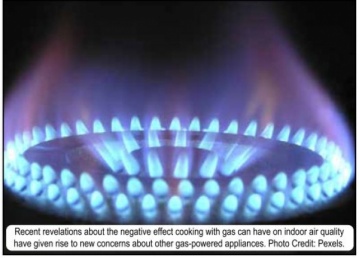
– L.J., Ronkonkoma, NY
Natural gas is almost as ubiquitous an energy source in American households as electricity. Indeed, 48 percent of U.S. homes stay warm with gas-powered furnaces while 38 percent do their cooking with gas. But recent revelations about the negative effect cooking with gas can have on indoor air pollution has given rise to new concerns about other types of gas-powered appliances inside our homes as well.
Gas cooktops may be the biggest offender given how much pollution they throw off when we use them, but gas-powered ovens, water heaters, clothes dryers and fireplaces are also worthy of concern. Gas-powered appliances emit carbon monoxide (CO), a colorless, odorless gas that, when inhaled, can cause headaches, dizziness, nausea – even death in high concentrations. Modern furnaces and appliances have safety features to prevent dangerous levels from building up, but they can still emit small amounts of CO.
Another concern with gaspowered appliances is the emission of nitrogen dioxide (NO2). NO2 is a reddishbrown gas that can irritate the eyes, nose and throat. It can also exacerbate respiratory conditions such as asthma and bronchitis. Gas stoves are the primary source of indoor NO2, but gas furnaces and other gas-powered appliances can also produce it. Gas-powered appliances also emit particulate matter (PM), another type of indoor air pollution. PM is a mixture of tiny particles that can be inhaled deep into the lungs. Exposure to PM can cause respiratory and cardiovascular problems, particularly in vulnerable populations such as children, the elderly and those with preexisting health conditions.
To minimize the negative effects of gas-powered appliances on indoor air quality, it is important to properly maintain and ventilate them. Regular maintenance, such as cleaning and replacing filters, can help ensure that appliances are running efficiently and emitting fewer pollutants. Additionally, proper ventilation can help remove pollutants from the air. Ventilation can be achieved by opening windows or using exhaust fans that vent to the outside.
Another option for reducing indoor air pollution from gas-powered appliances is to switch to electric varieties instead. Electric stoves and furnaces do not produce CO or NO2, and they emit far less PM than gas appliances. While electric appliances may have higher upfront costs, they can be more cost-effective over time due to lower operating costs and reduced maintenance needs.
If you are designing a new home from scratch, it’s a nobrainer these days to choose appliances powered by electricity not gas. But most of us don’t have that luxury, and it’s not easy to decide if it’s worth the expense and hassle of switching out an old gas-powered appliance with a shiny new electric one. The bottom line is “if it ain’t broke, don’t fix it,” as swapping out an old one for a new one generates more pollution overall thanks to the lifecycle costs of manufacturing.
But if your old appliance has reached the end of its useful life anyway, changing to an electric one may well be the best move.
CONTACTS: Gas stoves can generate unsafe levels of indoor air pollution, vox.com/energy-andenvironment/2020/5/7/21247602/gas-stove-cooking-indoor-airpollution-health-risks; Gas stoves pose health risks. Are gas furnaces and other appliances safe to use? /yaleclimateconnections.org/2023/03/gas-stoves-posehealth-risks-are-gas-furnaces-andother-appliances-safe-to-use/. EarthTalk® is produced by Roddy Scheer & Doug Moss for the 501(c) (3) nonprofit EarthTalk. See more at https://emagazine.com. To donate, visit https://earthtalk.org. Send questions to: question@earthtalk.org.


























